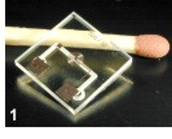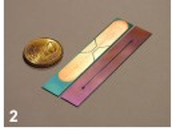The growing interest in chemistry on small sample volumes performed on chips sets the demand for analytical methods which can handle corresponding volumes. Nuclear magnetic resonance (NMR) is routinely used by chemists to study the chemical structure of (bio)molecules.
The basic principle of NMR consists of the measurement of the resonance of nuclear spins, present in a large and uniform magnetic field, where the resonance is excited and detected with a radio frequency (rf) coil. The resonance depends on the electron configuration around the specific nucleus in a molecule and on the magnetic moments induced by the adjacency of other nuclear spins. The effect of the electron configuration is expressed in a so-called chemical shift. The intensity of a specific resonance (i.e. the peak area in the spectrum) is proportional to the amount of spins with that resonance, and can therefore be used as a (relative) measure of the concentration of the species to which the nuclear spins belong.
|
When the sample volume shrinks, the rf coil - which is closely to the sample - has to shrink as well. A typical realization is shown in picture 1, [1]. The rf coil is a planar helix and the sample chamber is incorporated in a microfluidic chip. Despite many efforts, these approaches have not yet penetrated mainstream NMR spectroscopy. The most important problem is the fact that the nearby copper windings of the microcoil tend to induce static field distortions that limit both the resolution and the signal to noise performance.
|
We designed a novel route towards microchip integrated NMR analysis, [2]. The basic element in the design is a rf stripline which can be defined in a single layer lithographic process and which is fully scalable to smaller dimensions, see picture 2. Due to the non-complicated copper geometry, the static field distortion is very low, resulting in a high resolution detection system. A microfluidic channel is integrated, which makes this chip feasible for in-flow measurements.
Initial measurements have shown a very high sensitivity combined with a stunning resolution.
References
[1] H. Wensink, F. Benito-Lopez, D.C. Hermes, W. Verboom, H. Gardeniers, D.N. Reinhoudt, and A. van den Berg, Measuring reaction kinetics in a lab-on-a-chip by microcoil NMR, Lab on a Chip 5 (2005) 280-284.
[2] P.J.M. van Bentum, J.W.G. Janssen, A.P.M. Kentgens, J. Bart, J.G.E. Gardeniers, Stripline probes for nuclear magnetic resonance, Journal of Magnetic Resonance 189 (2007) 104–113.


